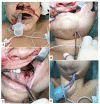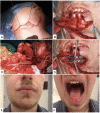Surgical access to the distal cervical segment of the internal carotid artery and to a high carotid bifurcation - integrative literature review and protocol proposal
- PMID: 36003126
- PMCID: PMC9388048
- DOI: 10.1590/1677-5449.202101931
Surgical access to the distal cervical segment of the internal carotid artery and to a high carotid bifurcation - integrative literature review and protocol proposal
Abstract
Several different maneuvers have been described for obtaining access to the distal cervical segment of the internal carotid artery or to a high carotid bifurcation. However there are different approaches to systematization of these techniques. The objective of this study is to review the techniques described and propose a practical protocol to support selection of the most appropriate technique for each case. The review is based on the results of database searches on PubMed Central, the Virtual Health Library (BVSalud), and SciELO for articles on the subject published in English or Portuguese from 1980 to 2021. Among the different maneuvers described, it appears reasonable that the first two steps should be to obtain access at the sternocleidomastoid muscle, followed by section or retraction of the digastric muscle posterior belly. If needed, temporary unilateral mandibular subluxation is an additional resource that is preferable to division of the styloid apparatus process, because of its lesser potential for morbidity. Even wider exposure can be obtained using mandibular osteotomies.
Resumo: Diversas manobras já foram descritas para o acesso ao segmento distal cervical da artéria carótida interna ou à bifurcação carotídea alta; entretanto, há divergências na sistematização dessas técnicas. O objetivo deste estudo é revisar as técnicas descritas e propor um protocolo prático que auxilie na seleção da técnica mais adequada para cada caso. Para isso, foi realizada uma busca nas bases de dados PubMed Central, Biblioteca Virtual em Saúde e SciELO por artigos sobre o tema, em língua inglesa ou portuguesa, publicados entre os anos de 1980 e 2021. Entre as manobras descritas, parece razoável que as duas etapas iniciais sejam a abordagem ao músculo esternocleidomastóideo, seguida pela secção/retração do ventre posterior do músculo digástrico. Caso necessário, a subluxação mandibular temporária unilateral é um recurso adicional e preferível à divisão do aparato estiloide, devido ao menor potencial de morbidade. Exposições ainda mais amplas podem ser obtidas com as osteotomias mandibulares.
Keywords: carotid artery diseases; internal carotid artery; mandibular osteotomy; temporomandibular joint.
Copyright© 2022 The authors.
Conflict of interest statement
Conflicts of interest: No conflicts of interest declared concerning the publication of this article.
Figures




















References
-
- Beretta F, Hemida SA, Andaluz N, Zuccarello M, Keller JT. Exposure of the cervical internal carotid artery: surgical steps to the cranial base and morphometric study. Neurosurgery. 2006;59(1) Suppl 1:ONS25–34, discussion ONS25-34. - PubMed
Publication types
LinkOut - more resources
Full Text Sources
